Decorative wrought iron bar designs.
A design system that allows you to create your own designs. The idea is very simple taking a plain design, and inserting decorative bars in place of plain bars. To create an individual designs of your choice. How you arrange those bars is up to you. Its not me creating the design its you. I will just do the extra work required to build the design and give you the information here on how to do it.
This applies to garden wall railings, Juliet balconies, Hand rails, Patio railings, gates and almost any thing that has a series of upright bars as part of its construction. ,
All images below should expand to a larger size on clicking on them.
The bar designs.
The bar designs are currently based on 4 individual parts or ideas, combining those parts or ideas makes a decorative bar. Which can replace a plain bar to create a railing, or balcony design or what ever.
Below are single items bars, that’s one process or part. It is possible to have multiple parts in a single bar. There are restriction, this is based on the length of the upright bar. So in a short railing there will be a limitation, as to what you can do. But even with a short bar you can create something truly individual in terms of design.
The twisted bar
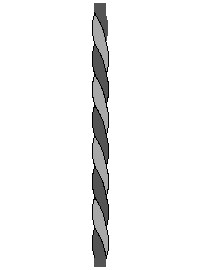
This is a square bar with a simple twist in. minimum length for a twist is 100 mm long, but usually they are around 250mm long. Each twist ideally needs a straight section (un twisted) of around 50 mm long each end. So in a 400 mm tall bar it is possible to have two twists one top and one bottom.
Price for a twist in 12mm square is around £3.00 per twist
Only works with square bar.
The circle bar
A circle welded to straight bar. The circle part is 100mm diameter, like the twist needs 50mm of plain bar. Ideal minimum length for each part is 200mm, although two circles can be in one bar 400mm long
Price for circle bar is £4.00 for 12mm square.
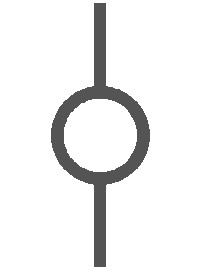
The Cage bar
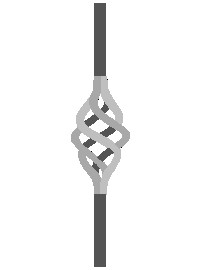
A cage or basket as its sometime called welded between two bars all ground flat so it looks like one piece.
minimum ideal length is 250mm
Price per unit £4.00 for 12mm square bar
only works with square bar.
The C scroll bar
Simple C scroll welded to an upright bar. The C scroll is usually 100mm tall. Width depends on height but at 100mm maximum width is around 65mm. The C scroll can easily be stacked, in that a 300mm bar can accept 3 scrolls high. Welded to the upright with the outer edge being clear of the adjacent upright. But can be made full width of the gap.
Price per pair £5.00
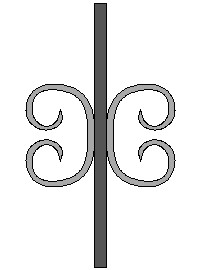
The S scroll bar
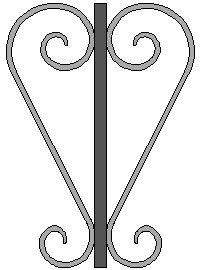
A pair of S scrolls welded to a bar. This is usually done so that the Scroll pair touch the upright bar they are on and the bar next to them. This does mean each scroll needs to be made to fit the gap between upright bars. Of the five pieces in this series it is the only one that needs to be made on a one off basis.
The S scroll is perhaps the most complicated bar designs but it does have the most options. The wider part of the Scroll i refer to as the head and the narrow part the tall. its possible to have a two headed scroll, where both parts are the same width. its also one of the only parts you can weld in as either mirror / flip vertically or horizontally. minimum height for an S scroll is 250mm but this does depend on the width of the head.
Price as per drawing £6.50 per pair. can be a single scroll rather than a pair £3.50
Scrolls have there own information page, which explains what they are a bit better. As they are incredibly adaptable and can be used in combination, to form some interesting designs
Points to note
Where space allows the parts don’t have to be central in the bar. For example the cage doesn’t have to be in the centre of the bar. It can be welded off centre allowing you to have a pattern where one cage is above centre and the next is low of centre. This can be useful when working with an arch, allowing for some strategic placement to create a good design.
Double Combo bars
Double combo bars, now that might sound like something you order from a fast food restaurant. But here it is how you can combine two bar parts together, or at least what they would look like. A few examples of what is possible here with 2 parts of a bar design.
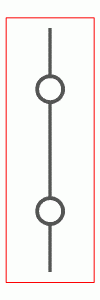
Two circles weld with centre gap. minimum height for bar is around 400mm
Price £8
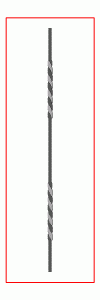
Two twists. minimum height is 400mm
Price £6
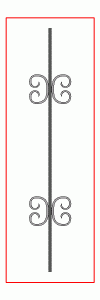
Two C scrolls. minimum height 400mm
Price £10
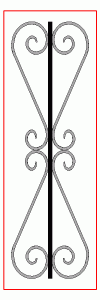
Double pair of scrolls. minimum height 500mm
Price £13
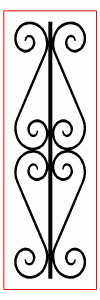
Double headed S scroll. minimum height 600mm
Price £14
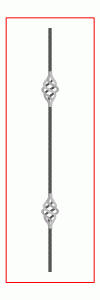
Double cage. minimum height 400mm
Price £8
Notes on S scrolls: They don’t have to be the full length of the bar but can be reduced in size (minimum of 250mm) so that they either become a centre piece as such (see below)
The above all use the same 2 parts in the bar this doesn’t have to be the case. it can be a mix
Triple combo bars.
Triple bars are usually for gates, railings, patio rails or Juliet balconies where the upright bar is at least 800mm tall, Although it does depend on the parts used to form the triple.
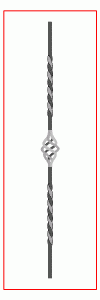
A cage as bar centre piece with a twist top and bottom. minimum height 500mm
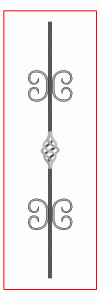
Cage centre, with C scroll top and bottom. minimum height 400mm
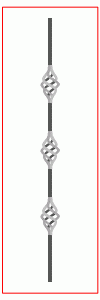
3 cages. minimum height 500mm
Price £12
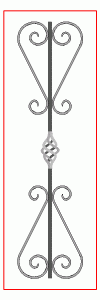
Cage with S scrolls. minimum height 600mm
Price £17
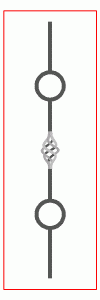
Cage and circle, minimum height 500mm
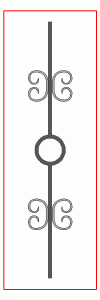
Centre Circle with C scrolls top and bottom.
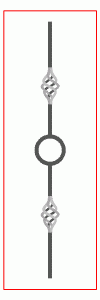
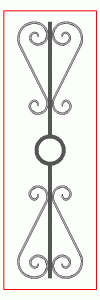
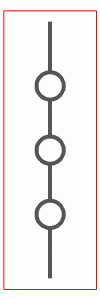
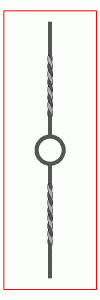
Circle and double twist. minimum height 500mm.
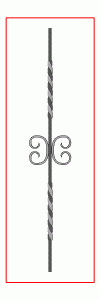
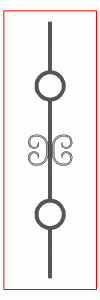
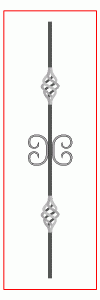
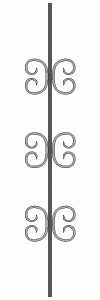
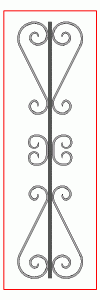
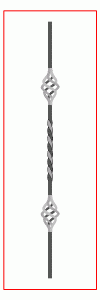
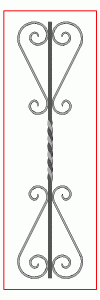
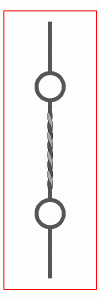
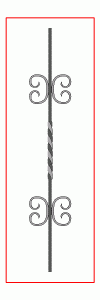
No triple twist, as its difficult to do. A full length twist running the entire length of the bar looks better
These below are best suited to Juliet balconies and patio railings, as they really need a bar length of 1000mm.

Scroll centred in a bar, as suggested above

4 S scrolled on a bar

nothing more than flipping the orientation of the scrolls

4 full width scrolls

C scroll jammed in between 2 S scrolls
The strange
Always a few strange ones that can be made with some careful planing. this may not always work much will depend on the length of the bar
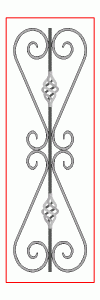
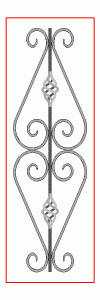
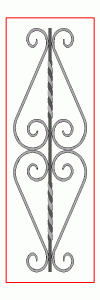
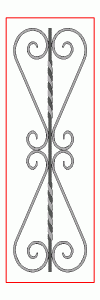
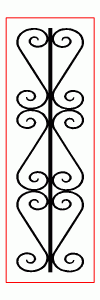
The majority of possibilities have been cover, although there are no doubt a lot permutations missing. Certainly on the double combos it doesnt have to be two circles in a bar, it could be a circle and C scroll. Circle at top C at bottom then flip the bar upside down for the next placement.
If you have an idea for a bar and its not here or mentioned, simply drop me an email and ask the question is it possible and how much…. If i get asked the same question on a bar to much it will get posted here eventually.
How to use the bar designs.
If you have read down as far as this, hopefully its given you some ideas. If you look around the website at the extended designs, more often or not you will notice the decorative bars have been strategically placed. its the same for almost all internet wrought iron designs. A lot depends on the size, on a short railing say 3 ft long you might only want one piece in the centre. Maybe just something from “the strange” section. its enough to make an impact without going over board. On a longer panel this may still work, chances are it will start to look a little plain towards the end. It might be a case of just dotting in something relatively simple. Either splitting the railing into thirds and putting something in each third. Or splitting the railing in two and place a centre piece in each half.
You don’t often go wrong, if you dot something in every fifth bar. More often or not working from the centre and work your way out. Depending on the size of the railing or gate, it might not mean there is a centre bar. You can almost always force a centre bar in. Just a case of closing or open the gap between each upright bar until you get one. This is perhaps the main reason i don’t really make railings with fixed bar gap. Easier but hardly ever works.
Ultimately you need to rough it out on paper, as it will give you a very quick guide to see if the design is going to work. If it looks promising then I can confirm price. Otherwise swap out a couple of the bar designs for others, until you get something you like. Then i can arrange a proper drawing and email it over. If it looks as you expected, we can progress from there and get it made.